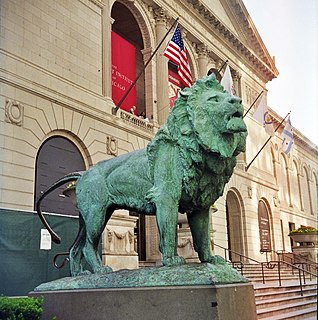
Installation art is an artistic genre of three-dimensional works that often are site-specific and designed to transform the perception of a space. Generally, the term is applied to interior spaces, whereas exterior interventions are often called public art, land art or intervention art; however, the boundaries between these terms overlap.
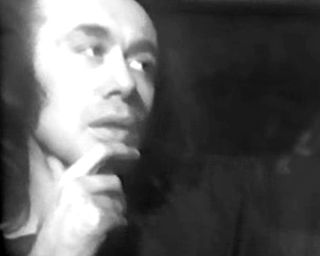
Vito Acconci was an influential American performance, video and installation artist, whose diverse practice eventually included sculpture, architectural design, and landscape design. His foundational performance and video art was characterized by "existential unease," exhibitionism, discomfort, transgression and provocation, as well as wit and audacity, and often involved crossing boundaries such as public–private, consensual–nonconsensual, and real world–art world. His work is considered to have influenced artists including Laurie Anderson, Karen Finley, Bruce Nauman, and Tracey Emin, among others. Acconci was initially interested in radical poetry, but by the late 1960s, he began creating Situationist-influenced performances in the street or for small audiences that explored the body and public space. Two of his most famous pieces were Following Piece (1969), in which he selected random passersby on New York City streets and followed them for as long as he was able, and Seedbed (1972), in which he claimed that he masturbated while under a temporary floor at the Sonnabend Gallery, as visitors walked above and heard him speaking.
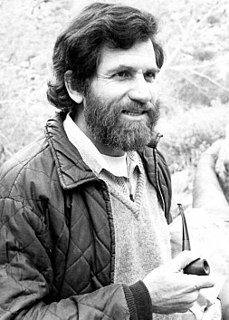
Allan Kaprow was an American painter, assemblagist and a pioneer in establishing the concepts of performance art. He helped to develop the "Environment" and "Happening" in the late 1950s and 1960s, as well as their theory. His Happenings — some 200 of them — evolved over the years. Eventually Kaprow shifted his practice into what he called "Activities", intimately scaled pieces for one or several players, devoted to the study of normal human activity in a way congruent to ordinary life. Fluxus, performance art, and installation art were, in turn, influenced by his work.
Deb Sokolow is a Chicago-based artist.

Lucas Samaras is an artist who was born in Kastoria, Greece. He studied at Rutgers University on a scholarship, where he met Allan Kaprow and George Segal. He participated in Kaprow's "Happenings," and posed for Segal's plaster sculptures. Claes Oldenburg, in whose Happenings he also participated, later referred to Samaras as one of the "New Jersey school," which also included Kaprow, Segal, George Brecht, Robert Whitman, Robert Watts, Geoffrey Hendricks and Roy Lichtenstein. Samaras previously worked in painting, sculpture, and performance art, before beginning work in photography. He subsequently constructed room environments that contained elements from his own personal history. His "Auto-Interviews" were a series of text works that were "self-investigatory" interviews. The primary subject of his photographic work is his own self-image, generally distorted and mutilated. He has worked with multi-media collages, and by manipulating the wet dyes in Polaroid photographic film to create what he calls "Photo-Transformations".

Boeing Galleries are a pair of outdoor exhibition spaces within Millennium Park in the Loop community area of Chicago in Cook County, Illinois, USA. The spaces are located along the south and north mid-level terraces, above and east of Wrigley Square and the Crown Fountain. In a conference at the Chicago Cultural Center, Boeing President and Chief Executive Officer James Bell to Chicago Mayor Richard M. Daley announced Boeing would make a $5 million grant to fund both the construction of and an endowment for the space.
Vesna Jovanovic is a contemporary American visual artist, best known for her works on paper that address embodied knowledge, subjectivity, and similar themes related to the human body.
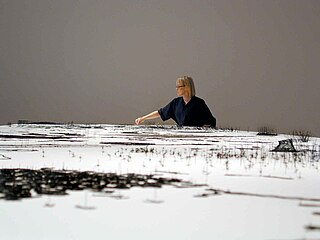
Anne Wilson is a Chicago-based visual artist. Wilson creates sculpture, drawings, Internet projects, photography, performance, and DVD stop motion animations employing table linens, bed sheets, human hair, lace, thread and wire. Her work extends the traditional processes of Fiber art to other media. Wilson is a professor in the Department of Fiber and Material Studies at The School of the Art Institute of Chicago.

Claes Oldenburg is an American sculptor, best known for his public art installations typically featuring large replicas of everyday objects. Another theme in his work is soft sculpture versions of everyday objects. Many of his works were made in collaboration with his wife, Coosje van Bruggen, who died in 2009; they had been married for 32 years. Oldenburg lives and works in New York

Rashid Johnson is an American artist who produces conceptual post-black art. Johnson first received critical attention when examples of his work were included in the exhibition "Freestyle," curated by Thelma Golden at the Studio Museum in Harlem in 2001—when he was 24. He has studied at Columbia College Chicago and the School of the Art Institute of Chicago. His work has been exhibited around the world and he is held in collections of many of the world's leading art museums.

Nick Cave is an American fabric sculptor, dancer, and performance artist. Cave's family was large in size and always supportive of his artistic interests. He claims his upbringing gave him an artistic attentiveness to found objects and assemblages. Cave started his artistic journey by manipulating fabrics from older sibling's hand me downs. After he graduated Hickman High School in 1977, he enrolled in the Kansas City Art Institute where he finished a Bachelor of Fine Arts in 1982. He is best known for his Soundsuits – wearable fabric sculptures that are bright, whimsical, and other-worldly. He also trained as a dancer with Alvin Ailey. His later sculptures focused on color theory, mixed media and large scale installations. He currently resides in Chicago, Illinois and is director of the graduate fashion program at School of the Art Institute of Chicago. He still continues to work on Soundsuits as well as works completed as a sculptor, dancer, and performance artist.

Glenn Thomas Walksler is an American contemporary artist based in Chicago. He is known primarily for works involving silkscreen printing and photographic site-specific installations. His Far East travels and interest in the urban environment have influenced his subject matter and themes.

Theaster Gates is an American social practice installation artist and a professor in the Department of Visual Arts at the University of Chicago. He was born in Chicago, Illinois, where he still lives and works. Gates' work has been shown at major museums and galleries internationally and deals with issues of urban planning, religious space, and craft. He is committed to the revitalization of poor neighborhoods through combining urban planning and art practices. He is represented by Richard Gray Gallery in Chicago.
Adelheid Mers is a visual artist, Associate Professor, and the Chair of the Department of Arts Administration and Policy at the School of the Art Institute of Chicago, Chicago, IL. As a visual artist her practice involves: drawing; digital design; animation; and diagramming texts, events and organizations. Her research interests include: Art Based Research, New Media Policy, and (Visual) Discourse Analysis. Mers' overlapping areas of expertise as a visual artist and a professor of arts management come together in the organograms, or maps of institutions, that she creates. These visualizations, based on theory and research, are a particularly creative way for institutions to assess themselves.
Michiko Itatani is a Chicago-based artist who was born in Osaka, Japan. After she received her BFA (1974) and MFA (1976) at the School of the Art Institute of Chicago in 1974 and 1976 respectively, she returned to her alma mater in 1979 to teach in the Painting and Drawing department. Through her work, Itatani explores identity, continuation, and finding one's way in the modern world. Her work depicts nude figures in an expressionist style. Itatani has received the Illinois Arts Council Artist's Fellowship, the National Endowment for the Arts Fellowship and the John Simon Guggenheim Fellowship. Her work is collected in many museums, including the Museum of Contemporary Art, Olympic Museum, Switzerland; Villa Haiss Museum, Germany; Musée national des beaux-arts du Québec, Canada; Museu D'art Contemporani (MACBA), Spain; and the National Museum of Contemporary Art, South Korea.
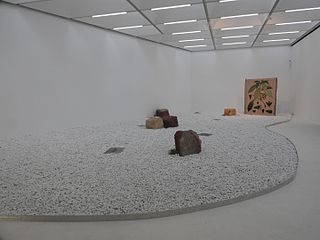
Otobong Nkanga (born 1974) is a Nigerian-born visual artist and performance artist, based in Antwerp. In 2015 she won the Yanghyun Prize.
Edra Soto is a Chicago-based multidisciplinary artist, curator, educator and co-director of the artist-run outdoor project space The Franklin.
ARC Gallery is an alternative exhibition space in Chicago, Illinois. Opening in 1973, it was one of the first women artists’ cooperatives in the Midwest along with Artemisia Gallery. ARC stands for Artists, Residents, Chicago and is one of the longest running women’s cooperative galleries in the country. The original members, recent art school graduates, banded together because they found few female mentors and exhibition opportunities. Through ARC, the members were able to promote their own artwork, feature solo and group exhibitions by many artists from across the county, and create discourse around feminism, art, theory, and practice. In 1979, ARC founded RAWspace, a raw part of the gallery dedicated to exhibiting installation work by visiting artists, selected by ARC members. RAWspace was one of the pioneering spaces in Chicago for the exhibition of installation work.


